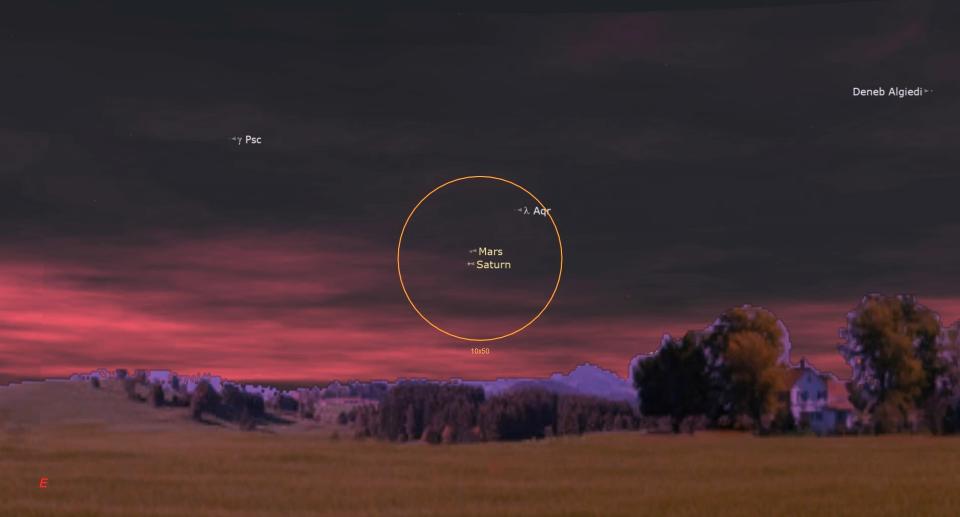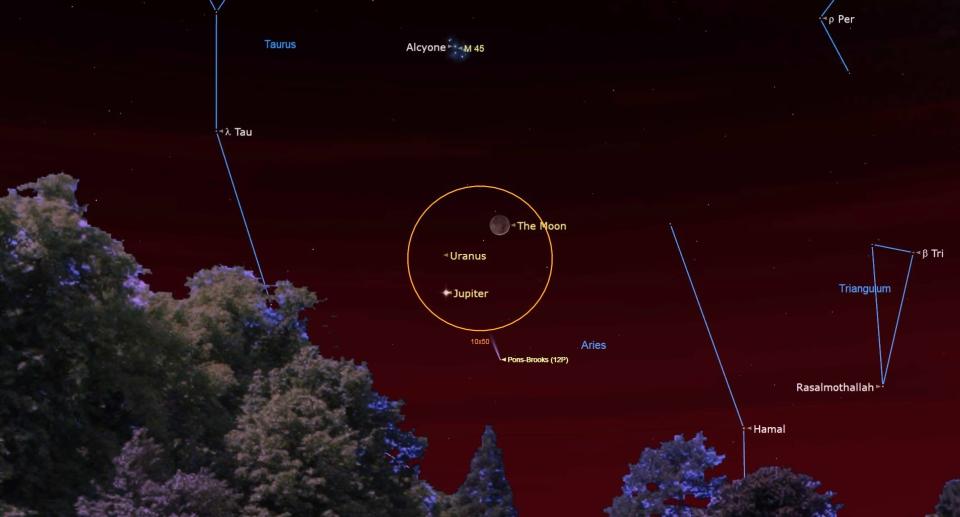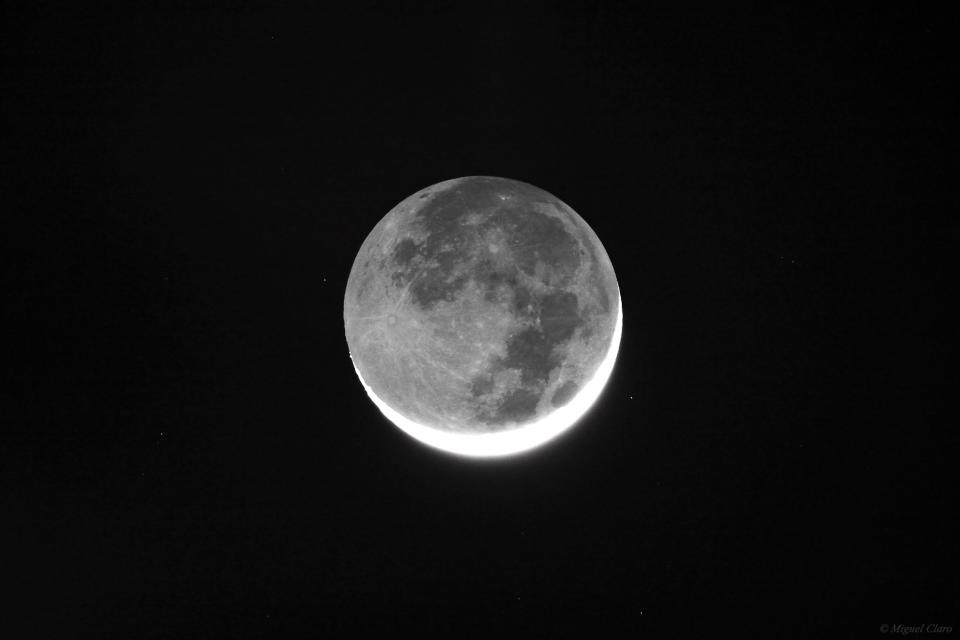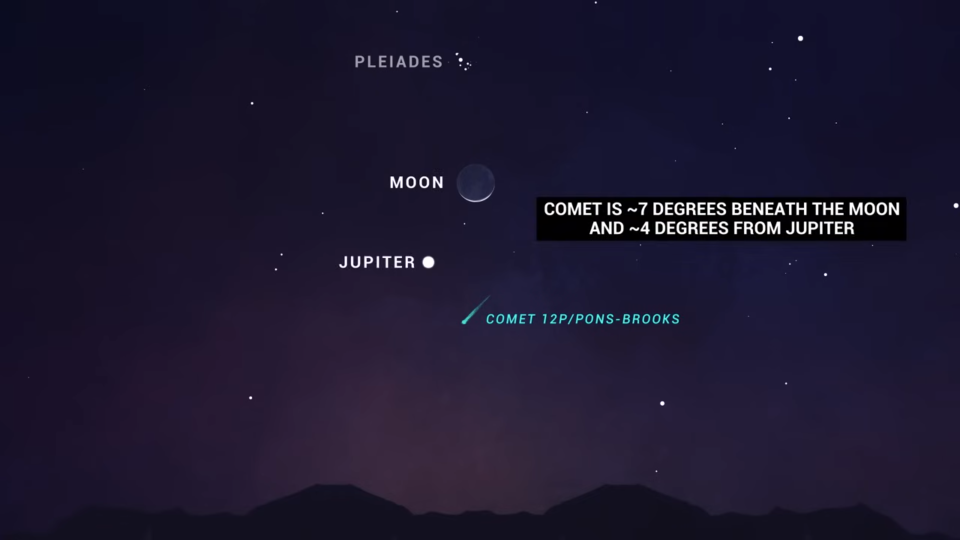In an unofficial sense, I’d like to call today (April 10) ‘View a Planet Day’.
In the early morning hours two planets will appear very close together and later that same day in the early evening sky we will have the chance to see Jupiter hovering close to a slender waxing crescent moon, making for quite a striking sight. And other celestial bodies will be seen and found among the brightest planets in the night sky.
Here are some interesting details about these upcoming meetings.
Mars and Saturn

TOP TELESCOPE CHOICE:


Looking for a telescope to see the planets in August? We recommend the Celestron Astro Fi 102 as the top choice in our best telescope for beginners guide.
These two “superior” planets – planets whose orbits are further away from the Sun than Earth’s – are currently visible about 30 to 40 minutes before sunrise, low near the east-southeast horizon. Binoculars will certainly help in locating them against the increasingly bright twilight sky.
Both planets will have almost the same brightness, separated by only a magnitude of 0.02. Saturn, the brightest (magnitude +1.14), will shine calmly beneath Mars (magnitude +1.16), with the two worlds separated by only half a degree, which is equal to the apparent width of the moon. (The actual closest approach to each other, just over four-tenths of a degree, comes after sunrise for much of North America.) If the unsettled weather denies you view of this duo on Wednesday, April 10, they will be close to appearing . the next morning at the same distance apart, although Mars will have shifted to Saturn’s upper left.
If you use a telescope equipped with a low-power eyepiece, you can place both planets in the same field of view. Along with the fact that they have nearly the same brightness, their contrast in colors is quite striking, with Mars glowing with a pumpkin hue compared to golden-yellow Saturn.
A pattern for these meetings
Saturn, at an average distance of 886.2 million miles (1.42 billion km) from the Sun, takes 29.46 years to orbit the Sun once. While Mars, at an average distance of 227.8 million km from the Sun, takes only 1.88 years to complete one trip around the Sun. As a result, Mars’ normal eastward motion among the stars is significantly faster than Saturn’s. As such, from our vantage point here on Earth, Mars will periodically appear to overtake Saturn in the sky.
Interestingly, when we combine the movements of Earth, Mars and Saturn, we find that the interval between the conjunctions of Mars and Saturn averages about every 2 years and 7 days. In the table below we list all these conjunctions from 2018 to 2030. Keep in mind that the upcoming conjunction will be the second closest conjunction during this twelve-year interval (though practically as close as the one in 2022).
Jupiter sideways with a waxing moon


It will soon be time to say goodbye to an object that has been a fixture in our evening sky since mid-autumn: the planet Jupiter.
Jupiter leaves our sky after many months of impressive display. Currently it sets about two hours and twenty minutes after the sun and you can still see it quite easily, albeit quite low in the western sky as early as 30 to 40 minutes after sunset. It is the brightest “star” in the area.
Wednesday evening we’ll be treated to a beautiful celestial scene as a very narrow crescent moon, 2.3 days past new phase (and the solar eclipse) and only 7 percent illuminated, will be about 4 degrees to the lower left of Jupiter. . Consider that your clenched fist, held at arm’s length, measures approximately 10 degrees. So it appears that Jupiter and the moon are separated by just less than half a fist. The narrow sliver of moon, tilted slightly to the right, almost seems to mimic the grin of the invisible Cheshire cat from Lewis Carroll’s “Alice’s Adventures in Wonderland.”
Striking earthshine!


Be sure to check out the moon to see if you can spot the phenomenon known as ‘Earthshine’, better known as ‘The Old Moon in the Arms of the New Moon’.
This is light that has traveled from the sun to Earth and been reflected back to the moon and then back to Earth – a ‘triple journey’. Binoculars bring out this effect better than with your naked eye alone. Earthshine is quite weak because only a small portion of the sunlight reflected from Earth reaches the moon. Because the moon is such a poor reflector, only 7 percent of this reflects back into space, and only a small portion of this returns to Earth. With binoculars the effect can be quite striking; the moon appears as an eerie yellow and blue-gray ball, almost three-dimensional.
Now add Jupiter, shining like a silvery jewel at the moon’s upper right, and you have a truly eye-catching sight. And as a bonus, the beautiful Pleiades star cluster shines 8 degrees above the moon. Make sure your western sky is clear of obstacles such as nearby buildings or trees so you can see everything at a glance.
And maybe a comet too!


And when nature is in a boastful mood, there’s another object you could try to find. That would be Comet 12P/Pons-Brooks, which will be about 6 and a half degrees below the moon and 4 degrees to the lower right of Jupiter.
The comet should now be near its maximum brightness, at magnitude +4.6; perhaps faintly visible to the naked eye from a dark location, but certainly accessible with a good pair of binoculars or a small telescope. Visually, the comet should look like a circular, wispy spot of light with possibly a faint gas tail extending upward and to the left of its small bright end (the comet’s head).
Farewell for now
With each passing evening, Jupiter sinks a little lower in the sunset glow. On April 23, the difference between sunset and Jupiter set will decrease to 90 minutes. On April 30, Jupiter will be only 5 degrees above the western horizon half an hour after sunset. The great world sets just over an hour after the sun, becoming increasingly difficult to see in the bright glow of twilight.
On May 4, Jupiter will be gone. It will conjunct the sun on May 18 and pass into the morning sky, where it will reappear at sunrise in early June.
So for Jupiter this is not really a ‘see you soon’, but just a ‘goodbye’ until later in the spring. As the American writer Richard Bach so aptly put it:
‘Do not be dismayed at parting. A farewell is necessary before you can meet again.’
Editor’s Note: If you take a great photo of Jupiter, the moon, Saturn, or Mars and would like to share it with Space.com readers, send your photo(s), comments, and your name and location to spacephotos@space.com.
Joe Rao is an instructor and guest lecturer in New York Hayden Planetarium. He writes about astronomy for Natural history magazinethe Farmer’s almanac and other publications.